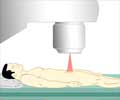The mechanisms by which prostate cancer cells spread to the bones have been uncovered by researchers at the University of Texas MD Anderson Cancer Center, Houston.
The researchers point out that death mainly occurs as a result of the tumour spreading to the bones, where it is known as an osteoblastic bone metastasis.According to them, treatments that deprive the tumour of male sex hormones (androgens) are usually effective, but only briefly as the tumours typically develop the ability to grow in the absence of androgens and the diseases progresses.
Now, Nora Navone and colleagues from the university have generated new data using two prostate cancer cell lines that lack expression of androgen receptors, and that were derived from the bones of an individual with osteoblastic bone metastases.
The data sheds light into the mechanisms by which prostate cancer osteoblastic bone metastases progress.
The androgen receptor, negative prostate cancer cell lines generated by the researchers grew when transplanted into immunocompromised mice and generated osteoblastic bone metastases.
The researchers found a protein known as FGF9 that expressed at higher levels in these cells lines than in other bone-derived prostate cancer cells, and induced bone formation in an in vitro organ culture assay.
Advertisement
Given that FGF9 was found to be expressed in all human prostate cancer osteoblastic bone metastases analysed during the study, the researchers believe that FGF9 plays a significant role in prostate cancer progression to osteoblastic bone metastases.
Advertisement
Source-ANI
RAS/L







![Prostate Specific Antigen [PSA] Prostate Specific Antigen [PSA]](https://www.medindia.net/images/common/patientinfo/120_100/prostate-specific-antigen.jpg)







